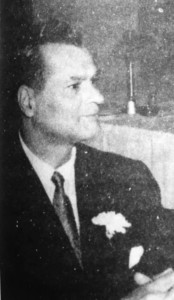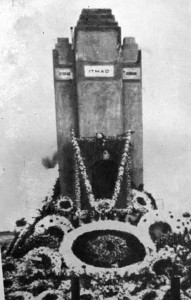Registered with the Registrar of Newspapers for India under R.N.I 53640/91
Vol. XXVIII No. 9, August 16-31, 2018
The Anglo-Indian Colonel in the INA
From 'Maddy's Ramblings' - a blog by Manmadhan Ullattil
September 6, 1945, Singapore – A small crowd is gathered in front of an Azad Hind monument on Connaught Drive. As Indian engineers position guncotton charges, Major Donald Brunt (Royal Engineers) is seen checking the fuses. The fuse is lit and the charges explode. Troops of the 17th Dogra Regiment push over the monument (marked ‘Itmad’ on its larger face) with poles; a civilian crowd claps and cheers enthusiastically; and a Malay policeman observes that the clock on the nearby tower, shows 6 p.m.

Col C.J. Stracey.

INA monumnet, Singapore.
A guard of honour of the 17th Dogra Regiment is back a few paces, salutes a brigadier in a kilt. The brigadier spoke later, explaining why this important symbol in the memory of INA soldiers, built by one Col C.J. Stracey, had to be demolished.
Sometimes you just stumble on a story while researching another and that is how I came across the tale of a fascinating character, an Anglo Indian named Cyril John Stracey, who served as a senior officer in the INA. That itself should evoke some curiosity, an Anglo Indian in a nationalist Indian outfit. It was not easy to unearth details of his life, but as it emerged gradually, bit by bit, it turned out to be a heartwarming tale.
The Stracey progeny were in all 11 (four died as infants), four boys and three girls who lived their lives mostly in India, each of them are examples of how to serve on the public. The eldest Patrick started the wildlife preservation society of India, Ralph became an ICS officer, Eric joined the police, Cyril, Doreen became a doctor, Margaret a nurse and Winnifred, a teacher.
The Straceys’ affair with India started from the early days of the EIC when John and Edward from Cork came to India. John worked in the offices of Hyder Ali as the British commercial agent representing the Bombay factory while Edward worked for the EIC in Madras, who were fighting Hyder. Both married Portuguese Indian girls, perhaps from Cochin, and later worked for the Nizam of Hyderabad while their children continued working for the British who had by then started to govern India. A descendant of one of them was Daniel Stracey, a district forest officer (his wife, Ethel was a protestant).
The Stracey children grew up in Richmond Town, Bangalore, then a quiet and cool part of the city, with a cantonment and an Anglo Indian minority. Cyril, who was born in 1915 in Kurnool, turned out to be quite different. He who chased adventure and traversed the world. He did his schooling in St Joseph’s, Bangalore, but did not complete his Intermediate and went on to join the Indian Military Academy in 1935 as a gentleman cadet. Eric records the difficulties the family had to endure in meeting Cyril’s 2 ½ year course expenses at Dehra dun (Pat deferred his marriage to help pay for his younger brother and their mother had to give up their home in Bangalore and move to Rangoon as a house guest with her brother- in-law) after their father passed away in 1932. Other family friends also chipped in with support as Cyril was not granted a scholarship which he deserved, for that was awarded instead to the son of a well-placed ICS officer. Eric recalls that Cyril as a youngster was actually more artistically inclined than soldierly, could draw and paint well as well as play the piano with some proficiency.
The IMA’s newly graduated officers were not considered on par with the Sandhurst graduated ones for they were Indian Commissioned Officers, not the King’s Commissioned Officers. ICO’s had a lower pay and were only meant to replace the VCO’s such as Risaldars, Jamedars and Subedars. The first two terms made them physically fit, adept in English, accounting and in the next three terms, they were provided strategic and tactical training. Camps in the plains and mountains provided them exposure to difficult terrains and tactics. After graduation (Gen Bewoor, Army Chief was his batch mate), Cyril was attached to the West Kent’s at Lucknow (this posting, according to Eric Stracey, with a British battalion was a compulsory part of initiation to regimental life before an IC joined his regular Indian battalion). Cyril’s formal posting was with the 1st Battalion of the 14th Punjab regiment at Bannu on the North West frontier.
In February 1941, the battalion was sent to Burma. Later, it became part of the 11th Indian Division’s 15th Brigade and was in September 1941 tasked with preparing the defenses at Jitra on the Malay-Thai border, anticipating a potential Japanese invasion.
On December 7th, the Japanese bombed Pearl Harbour, sanctioning a plan to conquer the SE Asian countries, such as Malaya, Thailand, Burma, and the Dutch of East Indies (Indonesia) for oil and food resources. On Dec 8th, the Japanese invasion forces landed at Kota Baru in northern Malaya and soon, Burma was overrun.
Units of the 1st division of the 14th Punjab regiment were at Jitra. Mohan Singh and Cyril Stracey were part of separate but incomplete defensive positions laid around Jitra. When the Japanese arrived on the 8th, they had solid air support and tanks. They decimated the under-equipped British Indians who had little answer for the Japanese tank supported from the air. The remaining British forces fled into the rubber plantations and hid. Both Mohan Singh’s and Stracey’s teams were hiding and while the former was contemplating his future, the latter was forced to assume leadership of a motley group of officers, soldiers, Gurkhas and so on, in the jungle.
The locals gave no shelter or support and eventually when the Japanese reached the location on 16th where these men were hiding, the hungry and battered men had no choice but to surrender. They were taken to the police HQ at Alor Setar where the Japanese started to separate the Indians from the English. Stracey was initially left with the British, but when his orderly piped in that Stracey was Indian, he was moved with the Indians. It was here that Stracey met his old pal Mohan Singh and Mohan Singh updated him of the INA activities and his newfound involvement together with Pritam Singh and Fujiwara. He explained that Rash Behari Bose had arrived there from Japan and agreed on a potential tie-up with the captured Indian soldiers to fight the British.
Stracey was confused and torn, wondering what to do, for his heart was not set on cooperating with the Japanese. He also noticed that some junior officers were now being awarded senior positions in the INA organisation, and was a bit miffed about it. Anyway as matters took their course, Stracey did not join Mohan Singh and so was confined with other British officers in the Alor Setar jail. As the number of prisoners increased, they were moved to Taiping, then to Kuala Lumpur and finally to Singapore, which had fallen to the Japanese, in November 1942.
During this year of confinement, Stracey began getting disillusioned. He caught up with Mohan Singh who had by then become a general, who had after the Farrer park meeting created the first INA and recruited a great many soldiers, totaling to 16,000 or so. Stracey decided to volunteer to the INA, sick of the discriminatory attitude shown by his fellow British officers and noting that they had anyway washed their hands off the Indian soldiers and thrown them to the mercy of the Japanese. Another reason was that he saw a number of his old colleagues already serving in the INA. Stracey was tasked with leading the 10,000 odd new volunteers which included Jawans, JCO’s, Subedar Majors, Subedars and Jamadars. He had to start a new army career as a 2nd lieutenant once again!
Stracey in his own words “was the only officer who saw the INA as a germ, a mere idea and who eventually participated in its obsequies”. Not only was he with Mohan Singh at the start of the INA conceptual discussions, but was also a witness to its disbanding and the first officer to be formally picked up and arrested after the retaking of Singapore by the Allies.
Meanwhile, things were not going well for Mohan Singh. The Fujiwara Kikan which was behind him had given way to the Iwakuro and Hikari Kikans which did not think much of Indians (or rate Indians as equals). Mohan Singh faced many other festering issues (INA recognition, use of Indians for manual labor, managing of Japanese misappropriation of Indian assets in Burma) with the Japanese over the INA recognition and issues about the tasks of the Indian Independence League (IIL). Mohan Singh’s relationship with the I Kikan as well as Rash Behari Bose turned sour resulting in him getting sidelined, dismissed, and arrested and transported to Pulau Ubin, an island off Changi point.
A terminally ill Rash Behari Bose had by now decided on appointing fresh blood to lead the large INA organisation, which was somewhat rudderless. It was into this vacuum that Subhas Chandra Bose stepped in, coming in from Germany. S C Bose took over as the new Supreme Commander and recreated the so-called ‘Second INA’. Stracey remained in Singapore as INA’s Adjutant General (Singapore was the rear HQ while Rangoon, where Bose lived, was the front HQ) and was the person responsible for the ‘A’ branch.
(To be concluded)


I’m feeling happy to read about our family ancestor. And so written.
A truly remarkable account for an Anglo Indian (considered in those days pro British). Loyalty to his troops deserted by British officers to the Japanese, channeled him toward the cause of India’s fight for independence. He was the only Anglo Indian to do this & reach high office in independent India’s IFS.A role model for his community.
I have worked under Ambassador Stracey in Madagascar. He was a good ambassador and a good and generous human being.
I do not know where the Stracey family is now.Some had gone to Australia.